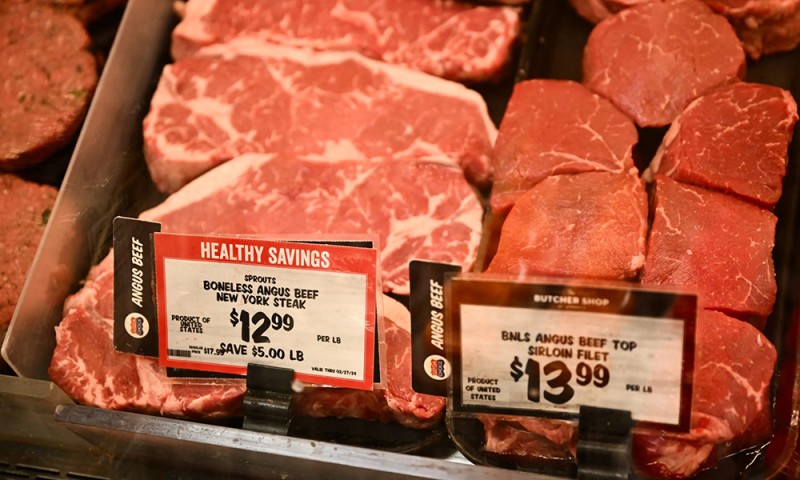
• 在鸡蛋价格回落之际,牛肉价格却持续攀升。自1月以来,每磅牛肉的平均价格已飙升9%,达到9.26美元。过去一年间,牛排价格上涨了12.4%。
随着鸡蛋价格终于回落,人们又开始能以可接受的价格吃早餐;但如果你正计划启动烧烤架,或许得先看看自己的储蓄账户余额。
美国牛肉价格正创下历史新高。美国农业部数据显示,自1月份以来,每磅牛肉的平均价格已飙升9%,达到9.26美元。过去一年间,牛排价格上涨了12.4%。
汉堡肉的情况同样不容乐观。过去一年,碎牛肉价格上涨了10.3%。
需求持续高企,而牛群数量却在萎缩,已降至74年来最低水平。饲料价格更高,进口牛肉成本也在上升。
出于对禽流感的担忧,数百万只鸡被扑杀,随后国内鸡蛋供应短缺,鸡蛋价格一度飙升。不过,鸡群数量最终开始恢复,供应增加使成本回落。
然而,牛肉市场的改善不会这么容易。
虽然牛群规模可以扩大,但一头牛成熟所需时间更长,且持续上涨的饲料价格预计短期内不会回落,这意味着养牛成本显著增加。与此同时,未来进口牛肉很可能面临关税,而进口牛肉约占美国牛肉消费量的8%。
牛肉价格下跌的最大可能性恰恰是所有人最不希望看到的情形。如果家庭收入下降到使牛肉成为奢侈品的程度,价格将会下跌,但这也会伤害到那些收入本就岌岌可危的农民。(*)
译者:刘进龙
审校:汪皓
• 在鸡蛋价格回落之际,牛肉价格却持续攀升。自1月以来,每磅牛肉的平均价格已飙升9%,达到9.26美元。过去一年间,牛排价格上涨了12.4%。
随着鸡蛋价格终于回落,人们又开始能以可接受的价格吃早餐;但如果你正计划启动烧烤架,或许得先看看自己的储蓄账户余额。
美国牛肉价格正创下历史新高。美国农业部数据显示,自1月份以来,每磅牛肉的平均价格已飙升9%,达到9.26美元。过去一年间,牛排价格上涨了12.4%。
汉堡肉的情况同样不容乐观。过去一年,碎牛肉价格上涨了10.3%。
需求持续高企,而牛群数量却在萎缩,已降至74年来最低水平。饲料价格更高,进口牛肉成本也在上升。
出于对禽流感的担忧,数百万只鸡被扑杀,随后国内鸡蛋供应短缺,鸡蛋价格一度飙升。不过,鸡群数量最终开始恢复,供应增加使成本回落。
然而,牛肉市场的改善不会这么容易。
虽然牛群规模可以扩大,但一头牛成熟所需时间更长,且持续上涨的饲料价格预计短期内不会回落,这意味着养牛成本显著增加。与此同时,未来进口牛肉很可能面临关税,而进口牛肉约占美国牛肉消费量的8%。
牛肉价格下跌的最大可能性恰恰是所有人最不希望看到的情形。如果家庭收入下降到使牛肉成为奢侈品的程度,价格将会下跌,但这也会伤害到那些收入本就岌岌可危的农民。(*)
译者:刘进龙
审校:汪皓
• Beef prices continue to climb as egg prices fall. Since January, the average price per pound has jumped 9% to $9.26. Over the past year, steak prices are up 12.4%.
Breakfast is starting to become affordable once again as egg prices have finally seen price drops, but if you’re thinking of firing up the grill, you might want to check your savings account first.
Beef prices are hitting new record highs. The Department of Agriculture shows that since January, the average price per pound has jumped 9% to $9.26. Over the past year, steak prices are up 12.4%.
Hamburger’s not much better off. The price of ground beef is up 10.3% in the past year.
Demand has remained high while herds have been shrinking—hitting their lowest levels in 74 years. Feed prices are higher and Imported beef is costing more as well.
Egg prices spiked due to avian flu concerns, which resulted in the slaughter of millions of chickens and a subsequent shortage of domestically produced eggs. Chicken populations eventually started to recover from the slaughter, though, which increased the supply, bringing costs back down.
It won’t be that easy with beef.
While herd sizes can grow, it takes longer for a cow to mature—and the rising price of feed isn’t expected to decline anytime soon, meaning it costs a fair bit more to raise the cattle. Imports, meanwhile, are likely to be subject to tariffs moving forward, and those make up about 8% of U.S. beef consumption.
The best chance for a price drop is the scenario everyone wants to avoid. If household incomes drop to the point that beef becomes a luxury, prices will decline, but that will also hurt farmers, whose incomes are already perilous.

